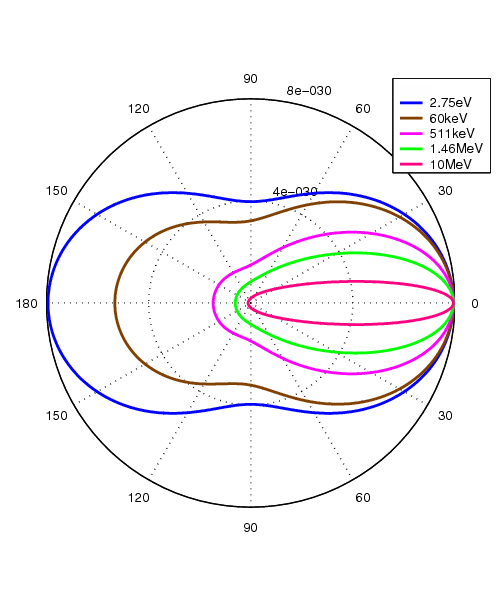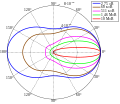File:Klein-Nishina distribution.png
Klein-Nishina_distribution.png (500 × 600 pixels, file size: 40 KB, MIME type: image/png)
| This is a file from the Wikimedia Commons. Information from its description page there is shown below. Commons is a freely licensed media file repository. You can help. |
Summary
| DescriptionKlein-Nishina distribution.png |
English: The Klein-Nishina distribution of photon scattering angles over a range of energies.
Visible light (2.75eV) will scatter over all angles and results in the light from the solar corona during a total solar eclipse. This is very well described by classical electrodynamics (Thomson Scattering). X rays (60keV) emitted during L to K shell transitions in X ray machines' tungsten targets will favourably scatter forward through the patient although back scattering will also occur. Photons generated through positron anihilation (511keV) during PET will rarely back scatter. Characteristic potassium-40 (1.460MeV) photons found in household salt will scatter forward and rarely back scatter. Gamma-ray bursts (10MeV) almost exclusively forward scatter.Deutsch: Die Klein-Nishina-Verteilung der Photonenstreuung in Abhängigkeit von der Strahlungsenergie.
Sichtbares Licht (2.75eV) streut in alle Richtungen, zu sehen beim Licht der Sonnencorona während einer totalen Sonnenfinsternis. Dies wird sehr gut durch die klassische Elektrodynamik beschrieben (Thomson-Streuung). Röntgenstrahlen (60keV) senden bei L-zu-K-Schalenübergängen Röntgenstrahlen aus, den die Wolfram-Targets der Maschinen günstig in Richtung durch den Patienten streuen, obwohl ein Teil der Strahlung auch wieder zurückstreuen kann. Durch Positronen-Annihilation (511keV) erzeugte Photonen bei einer Positronen-Emissions-Tomographie (PET) streuen seltener zurück. Charakteristische Kalium-40-Photonen (1.460MeV), gefunden im Haushaltssalz, streuen größtenteils vorwärts und ganz selten in rückwärtiger Richtung. Gamma-Strahlen-Ausbrüche (10MeV) streuen fast ausschließlich vorwärts gerichtet.Русский: Распределение Клейна - Нишины интенсивности рассеяния фотонов в зависимости от угла рассеивания для разных энергий.
Видимый свет (2,75 эВ) рассеивается вперед и назад одинаково по всем углам и образует излучение солнечной короны видимое во время полного солнечного затмения. Это рссеяние очень хорошо описывается классической электродинамикой (томсоновское рассеяние). Рентгеновские лучи (60 кэВ), испускаемые при переходе в электронных оболочках L в K в вольфрамовых мишенях в рентгеновских аппаратах будут более рассеиваться вперед через тело пациента, хотя рассеяние назад также будет происходить. Фотоны возникающие в результате аннгиляции позитронов (511 кэВ) менее вероятно рассеиваются назад. Фотоны возникающие при распаде калия-40 (1,460 МэВ), рассеиваются в основном вперед и с малой вероятностью назад. Гамма-всплески галактических гамма-источников (10 МэВ) рассеиваются почти исключительно вперед. |
| Date | |
| Source | Own work |
| Author | Dscraggs |
| Other versions |
|

|
File:Klein-Nishina distribution-en.svg is a vector version of this file. It should be used in place of this PNG file when not inferior.
File:Klein-Nishina distribution.png → File:Klein-Nishina distribution-en.svg
For more information, see Help:SVG.
|
Licensing
| Public domainPublic domainfalsefalse |
| I, the copyright holder of this work, release this work into the public domain. This applies worldwide. In some countries this may not be legally possible; if so: I grant anyone the right to use this work for any purpose, without any conditions, unless such conditions are required by law. |
| Annotations InfoField | This image is annotated: View the annotations at Commons |
The Klein-Nishina distribution of photon scattering angles over a range of energies. Blue (2.75eV) will scatter over all angles and results in a blue sky as seen from all directions.
X rays (60keV) emitted during L to K shell transitions in X ray machines' tungsten targets will favourably scatter forward through the patient although back scattering will also occur.
Photons generated through positron anihilation (511keV) during PET will rarely back scatter.
Characteristic pottassium-40 (1.460MeV) photons found in household salt will scatter forward and rarely back scatter.
Gamma-ray bursts (10MeV) almost exclusively forward scatter.
Captions
Items portrayed in this file
depicts
5 April 2009
File history
Click on a date/time to view the file as it appeared at that time.
| Date/Time | Thumbnail | Dimensions | User | Comment | |
|---|---|---|---|---|---|
| current | 19:30, 5 April 2009 |  | 500 × 600 (40 KB) | Dscraggs | {{Information |Description={{en|1=The Klein-Nishina distribution of photon scattering angles over a range of energies. Blue (2.75eV) will scatter over all angles and results in a blue sky as seen from all directions. X rays (60keV) emitted during L to |





